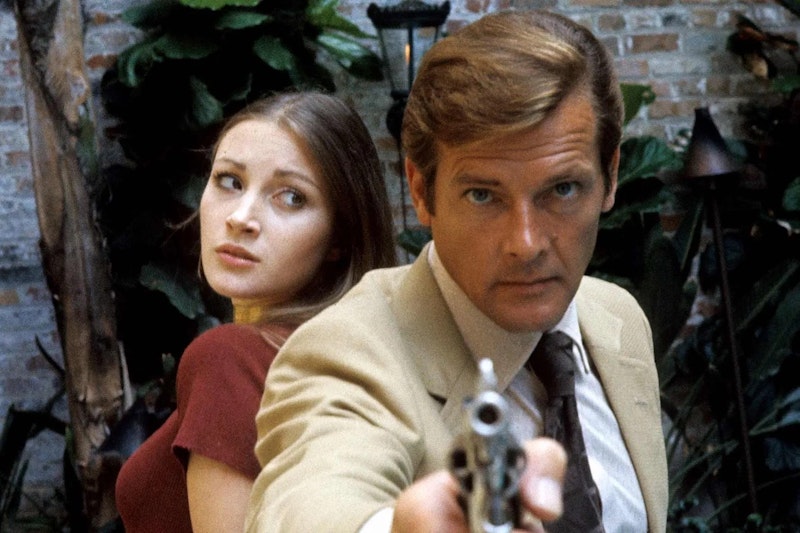James Bond’s eighth cinematic escapade, Live and Let Die, came out in 1973. It starts a new phase for the Bond movies, the first to star Roger Moore as Bond. But with high-tech spy stories no longer as popular as they used to be, it’s also the first Bond movie that reacts to trends rather than setting them. Later Bonds would be influenced by the popularity of kung-fu films and science fiction; this one’s a Bond take on blaxploitation. Accordingly, how you feel about it will depend in part on your view of the racism depicted by the movie.
I’m amused by the film’s conceit that every Black person in the United States is actively working against the government and law enforcement, which plays to me as unintentional self-satire of the early-1970s White paranoia. The depiction of Voodoo is a more unpleasant mass of clichés. But that’s the movie: often interesting in a tongue-in-cheek way, but inconsistent.
Bond’s sent to New York to investigate the assassination of three MI6 agents, two of whom died in the US while the third was killed in the Caribbean country of San Monique; San Monique’s ruler, Doctor Kananga (Yaphet Kotto), is at his American embassy while he visits the UN. There’s an assassination attempt on Bond, Bond investigates a crime lord called Mr. Big in Harlem, is captured, meets a beautiful tarot reader named Domino (Jane Seymour), escapes, and carries on his investigation in San Monique. There Bond meets the tarot-card reader again and seduces her, after which he takes her to New Orleans, is captured again, and learns Mr. Big and Kananga are one and the same.
Kananga plans to flood the US with free heroin, driving other drug syndicates out of business and creating a horde of addicts. With competitors bankrupt, he’ll raise the prices. It’s a viable business strategy, as Amazon’s proved (in other fields). But Bond will have none of it; he escapes, and returns to San Monique for an explosive climax.
This isn’t entirely distant from the book, for better or worse. There might’ve been White British conservative novelists in 1954 who could’ve come up with convincing African-American characters and dialogue, but Ian Fleming wasn’t one of them; the movie cuts and adapts accordingly. Mr. Big’s connection to the Soviet Union is eliminated in favor of his own island nation, and a gold-smuggling plot becomes drug-dealing. The climax is reimagined, mostly for the better, but the movie lacks a lot of the science-fictional strangeness of earlier movies, as well as a properly ambitious villain. This is nominally in line with the blaxploitation feel, perhaps smaller-scale than earlier adventures, but just as incredible if a touch grittier.
Director Guy Hamilton and writer Tom Mankiewicz returned from 1971’s Diamonds Are Forever, as did cinematographer Ted Moore. This one nevertheless looks a little different than earlier Bonds, with more zooms and 1970s-style camera moves, including some handheld work—rare to this point in the Bond films, and emphasizing the lower-key tone of this installment. The visuals otherwise are oddly inconsistent, with production designer Syd Crain contributing some lovely interior designs (a magic shop, a bar, Kanaga’s secret bases) but exterior shots necessarily having to feature boxy 1970s cars and dull 70s architecture, the opposite of Bond glamour.
Yaphet Kotto was a genuinely interesting actor who makes surprising choices, but he appears embarrassed and even disgusted to be in the film; according to his later comments the role of Kananga apparently didn’t meet his hopes. But the big casting choice was replacing Sean Connery with Roger Moore. For this movie, at least, it works.
Moore’s Bond is smoother and more gentlemanly than Connery’s, with a drier and more effective wit. That comes off well in a film with a bit more overt comedy than its predecessors, much of which derives from Bond being a very English fish out of water in early-1970s Harlem. But Moore also has a credible physicality. He was older than Connery (44 when this movie come out, Connery 41 when Diamonds Are Forever was released) yet feels younger, with an appealing energy and appetite for the part.
The plot’s scattershot, often the case with Bond films, and the ending’s anticlimactic. But it has an idea of what it wants a James Bond movie to be. It’ll let a minor character say “holy shit” as a laugh line, but nobody can say “fuck.” It has a sense of how much sex there should be, and how much violence spread across how many action set-pieces (which are overall well-executed, especially a speedboat chase). It may have overindulged in comedy and self-satire, particularly in an extended scene with an unfunny Southern sheriff, but the movie more-or-less gets away with it.
Still, you notice the lack of Bond’s old enemies in SPECTRE and their high-tech wizardry. There’s no sense of 1970s futurism the way 60s Bond films developed a visual sense of 1960s technology. There’s no 70s equivalent here to the look of Dr. No’s secret lair or Goldfinger’s model of Fort Knox. As a villain, Kananga’s underdeveloped, despite his different identities. The occasional sense that almost every Black person in the United States and beyond is a part of his organization only works as comedy—there’s no sense of paranoia such as SPECTRE could occasionally conjure.
Live and Let Die ends up a fun movie if you’re willing to watch it with an ironic attitude. It’s disposable, with an underwhelming ending and that speedboat chase hurts the narrative momentum of the film.

